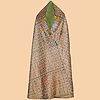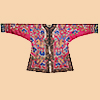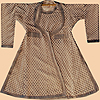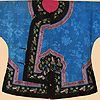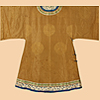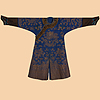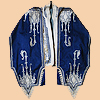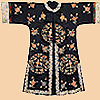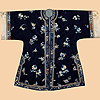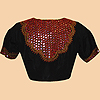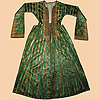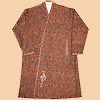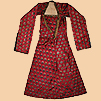 An Important Safavi Silk Brocade Mantel
An Important Safavi Silk Brocade Mantel

AN IMPORTANT SAFAVID SILK BROCADE MANTLE, POSSIBLY KASHAN OR
ISFAHAN, EARLY 17TH CENTURY
AN IMPORTANT SAFAVID SILK BROCADE MANTLE, POSSIBLY KASHAN OR ISFAHAN,
EARLY 17TH CENTURY
silk inner structure warps with tan supplementary satin surface warps: complementary twill
pattern wefts, with details in silver and silver-gilt metal thread brocading, made in five
pieces seamed along selvages, three central panels each 73cm wide selvage to selvage;
lateral panels 33.5cm wide, each full panel with six vertical main stripes, 9cm wide each,
with main repeating motif of an octofoil with flower centre and four flanking birds (finches),
alternating narrow hands 2.5cm wide, displaying a rosette and framing leaves on a dark
blue ground, overall colour palette is that of contemporary "Polonaise" rugs, backed by
old, dark green linen
Silk
Size 122 by 288cm.
PROVENANCE
Formerly in the collection of the Cleveland Museum of Art, Inv. No. 173.15 / PC XVIII.
CATALOGUE NOTE
The production of the semi-circular mantle in Iran was restricted to the ruler and high dignitaries but was occasionally
presented as a mark of favour to important foreign visitors. For example, portraits of the English envoy Robert Sherley
by Anthony van Dyke in 1622 and a later version of 1628 show him adorned with a mantle in a large flower pattern
"...Most likely the robe of honour presented to Sherley by Shah 'Abbas in 1598" (see S. Canby [Ed.], Shah 'Abbas and
the Remaking of Iran, London, 2009, p.56, no.12 and fig.1 above). Furthermore, the engraved portraits of Jean
Baptiste Tavernier in his Receuil de Plusieurs Relations et Traitez Singuliers et Curieux, Paris, 1679, show him
sporting a fur-lined mantle of similar cut. The style obviously endured at the Persian court as the last Shah Reza
Muhammad Pahlavi can be seen wearing a similar garment as ceremonial attire in various photographs as recently as
the 1970s.
During the seventeeth century, the semi-circular mantle was worn over a fitted, knee length, wrap-and-tie coat. Many
examples were sent as gifts to the West (exchange presents were expected), but in Iran few survived as they were
often burned to extract the metal thread (see P. Scott, The Book of Silk, London, 1993, p.147).
